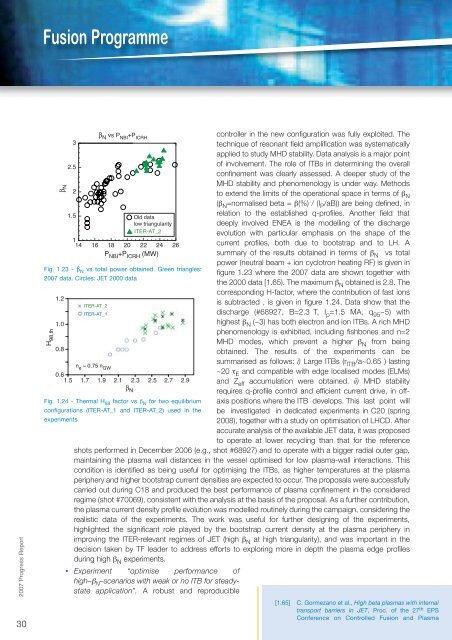Fusion Programme - ENEA - Fusione
Fusion Programme - ENEA - Fusione
Fusion Programme - ENEA - Fusione
- No tags were found...
You also want an ePaper? Increase the reach of your titles
YUMPU automatically turns print PDFs into web optimized ePapers that Google loves.
<strong>Fusion</strong> <strong>Programme</strong>2007 Progress Report30β N vs P NBI +P ICRHcontroller in the new configuration was fully exploited. The3technique of resonant field amplification was systematicallyapplied to study MHD stability. Data analysis is a major point2.5of involvement. The role of ITBs in determining the overallconfinement was clearly assessed. A deeper study of theMHD stability and phenomenology is under way. Methods2to extend the limits of the operational space in terms of β N(β N =normalised beta = β(%) / (I P /aB)) are being defined, in1.5relation to the established q-profiles. Another field thatOld datalow triangularitydeeply involved <strong>ENEA</strong> is the modelling of the dischargeITER-AT_2evolution with particular emphasis on the shape of the114 16 18 20 22 24 26 current profiles, both due to bootstrap and to LH. AP NBI +P ICRH (MW)summary of the results obtained in terms of β N vs totalpower (neutral beam + ion cyclotron heating RF) is given inFig. 1.23 - β N vs total power obtained. Green triangles:figure 1.23 where the 2007 data are shown together with2007 data. Circles: JET 2000 datathe 2000 data [1.65). The maximum β N obtained is 2.8. Thecorresponding H-factor, where the contribution of fast ions1.2is subtracted , is given in figure 1.24. Data show that theITER-AT_2ITER-AT_1discharge (#68927, B=2.3 T, I p =1.5 MA, q 95 ~5) with1.0highest β N (~3) has both electron and ion ITBs. A rich MHDphenomenology is exhibited, including fishbones and n=2MHD modes, which prevent a higher β N from being0.8obtained. The results of the experiments can besummarised as follows: i) Large ITBs (r ITB /a~0.65 ) lastingn e ~ 0.75 n GW0.6 ~20 τ E and compatible with edge localised modes (ELMs)1.5 1.7 1.9 2.1 2.3 2.5 2.7 2.9 and Z eff accumulation were obtained. ii) MHD stabilityβ Nrequires q-profile control and efficient current drive, in offaxisFig. 1.24 - Thermal H 98 factor vs β N for two equilibriumconfigurations (ITER-AT_1 and ITER-AT_2) used in theexperimentspositions where the ITB develops. This last point willbe investigated in dedicated experiments in C20 (spring2008), together with a study on optimisation of LHCD. Afteraccurate analysis of the available JET data, it was proposedto operate at lower recycling than that for the referenceshots performed in December 2006 (e.g., shot #68927) and to operate with a bigger radial outer gap,maintaining the plasma wall distances in the vessel optimised for low plasma-wall interactions. Thiscondition is identified as being useful for optimising the ITBs, as higher temperatures at the plasmaperiphery and higher bootstrap current densities are expected to occur. The proposals were successfullycarried out during C18 and produced the best performance of plasma confinement in the consideredregime (shot #70069), consistent with the analysis at the basis of the proposal. As a further contribution,the plasma current density profile evolution was modelled routinely during the campaign, considering therealistic data of the experiments. The work was useful for further designing of the experiments,highlighted the significant role played by the bootstrap current density at the plasma periphery inimproving the ITER-relevant regimes of JET (high β N at high triangularity), and was important in thedecision taken by TF leader to address efforts to exploring more in depth the plasma edge profilesduring high β N experiments.H 98,thβ N• Experiment “optimise performance ofhigh–β N –scenarios with weak or no ITB for steadystateapplication”. A robust and reproducible[1.65] C. Gormezano et al., High beta plasmas with internaltransport barriers in JET, Proc. of the 27 th EPSConference on Controlled <strong>Fusion</strong> and Plasma













